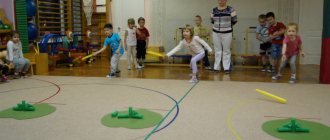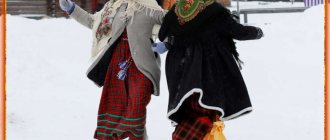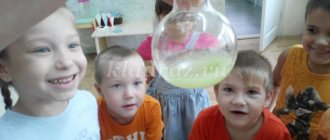Outdoor games of peoples for young children
Bykhovets L.A. Outdoor games of peoples for young children // Sovushka. 2021. N1(11). URL: https://kssovushka.ru/zhurnal/11/ (access date: 12/29/2021).
Order No. 76321
APPENDIX: Long-term plan for introducing young children to folk outdoor games
"Give the children more and more
content of the general, human,
global, but mainly
try to introduce them to this through
native and national phenomena"
V. Belinsky
Outdoor play is a natural companion in a child’s life, a source of joyful emotions that have great educational power.
Outdoor play is a complex emotional activity of children, aimed at solving motor problems, based on movement and the presence of rules.
Outdoor play activates breathing, blood circulation and metabolic processes, improves movements, and develops their coordination. Forms speed, strength, endurance, teaches children to act in accordance with the rules, act consciously in a changing game situation, and learn about the world around them. Activates memory, ideas, develops thinking, imagination, replenishes vocabulary and enriches children's speech. Teaches how to act in a team, obey common requirements, forms honesty, justice, discipline, teaches friendship, empathy, helping each other, develops a sense of rhythm, and promotes mastery of spatial terminology.
In the process of raising children on the ideas of folk pedagogy, a set of tasks of social-communicative, emotional-moral, cognitive-speech, physical development is solved by means of folk games:
- To develop in children an emotionally active attitude and effective interest in the games of the peoples of the Southern Urals.
- Create conditions for the manifestation of children's gaming culture.
- Enrich the child’s cognitive and speech sphere with knowledge of the rules of folk games, the foundations of the history and culture of the peoples of the Southern Urals.
- To promote the effective introduction of children to folk culture through games of the peoples of the South Ural region.
- Create conditions for the use of different types of folk games in independent, free play activities.
- Strengthen children's gaming experience based on the use of moral values of the child's interaction with adults and peers.
In early preschool age, in accordance with age characteristics and abilities, games can be used to a greater extent, such as: fun games, games with folk toys (Babinsky nesting dolls, Bogorodsk toys, insert eggs, etc.), outdoor and round dance games.
Folk outdoor games are a traditional means of pedagogy. From time immemorial, they clearly reflected the way of life of people, their way of life, work, national principles, ideas about honor, courage, courage, the desire to have strength, dexterity, endurance, speed and beauty of movements, to show ingenuity, endurance, creativity, resourcefulness, will and the desire to win.
In our country, the revival of the ancient culture of all peoples is taking place everywhere and steadily, national traditions in art and literature are developing and improving, containing the richest layers of folklore, which include folk outdoor games.
Taking into account demographic data, a large percentage of representatives of Russian, Bashkir and Tatar nationality live in the Ural region. Therefore, in our opinion, the games of these peoples must be used in the educational process of our kindergarten.
In the lives of modern children, folk games are a well-forgotten old thing, a return to normal. These games have stood the test of time.
Each nation has its own collection of games . The Russian nation is socially formative, therefore other nationalities have united around it.
The folk games of the inhabitants of the Southern Urals have a lot in common.
They were created for the purpose of raising children, entertainment (they were created for centuries).
All folk games are games with rules (the author is the people).
The games have a game beginning in the form of counting rhymes and dialogues.
The games reflect the mentality of the people, the main activities of Muslim peoples are hunting, cattle breeding, the Cossacks - border guarding.
In terms of content, all folk games are classically laconic, expressive and accessible to children.
The use of folk games helps children become acquainted with the origins of the culture of their people, with the origins of gaming culture in general.
It is necessary to systematically use folk games, adhering to the ideas of folk pedagogy, alternating games of different nationalities, alternately including moving, verbal, and round dancing.
The significance of folk games and their developmental effect is multifaceted:
- In games, folk wisdom.
- With the help of folk games, preschoolers can get acquainted with the mentality of other peoples.
- Folk games carry information about crafts.
- Respect for other peoples (tolerance)
- Bring an element of novelty into the modern culture of children
- The problem of fathers and children is smoothed out, because children don't know what their parents played.
- Therapeutic effect (pleasure)
In early preschool age, in accordance with age characteristics and capabilities, folk games, to a greater extent, can be used, such as: games with speech accompaniment (miniatures of oral folk art), fun games, games with folk toys, outdoor games, occasionally round dances.
Outdoor games are mainly collective, so children develop basic skills to navigate in space, coordinate their movements with the movements of other players, find their place in a column, in a circle, without disturbing others.
The joint actions of young children create conditions for common joyful experiences and common active activity. In collective outdoor games, children learn to play together, give in and help each other.
All games for preschool children based on movement can be divided into two large groups: plot and plotless games, and fun games. The first group consists of games that differ in content, in the organization of children, in the complexity of the rules and in the uniqueness of motor tasks. In the younger groups of kindergarten, plot-based outdoor games are most used, as well as simple games without a plot, such as traps and fun games. Plotless games with elements of competition are not yet available to children. At the same time, when working with children of primary preschool age, play exercises are widely used, occupying an intermediate place between gymnastic exercises and outdoor games.
Games of this type are based on the experience of children, their ideas and knowledge about the surrounding life, natural phenomena, the lifestyle and habits of animals and birds.
Some features of animal behavior (the cunning of a fox, the habits of predators - wolves, pikes, the speed of movements of hares, birds, the caring nature of a hen, etc.) serve as the basis for developing the plot and establishing the rules of the game.
The plot of the game and the rules determine the nature of the movements of the players. In one game, kids, imitating horses, run, raising their knees high, in another game they jump like bunnies, etc. In story games, therefore, the movements performed are of an imitative nature.
Children begin, stop, or change movements in accordance with the rules of the game, which are usually closely related to the plot and determine the behavior and relationships of the players. In some story games, the actions of the players are determined by the text (“Bear the Bear in the Forest,” “Geese and Swans,” “Hares and the Wolf,” etc.).
In story games, usually the majority of children portray, for example, birds, bunnies, and one child or teacher becomes the performer of a responsible role - a wolf, a fox, a cat. Children's actions are closely interconnected. Thus, the activity of a child playing the role of a wolf encourages the other participants in the game - the hares - to move faster and more energetically. This constitutes children's play actions. However, each child, when playing, demonstrates independence, initiative, speed and dexterity to the best of his abilities.
Since in the games of this group a group of children acts, obeying the rules, this largely determines their behavior and relationships. Kids are accustomed to coordinated collective actions in certain conditions, learn to change the method and nature of movements according to signals and in accordance with the rules. For example: birds quickly fly away to their nests as soon as it starts to rain, etc.
Thematic outdoor games are widely used in all age groups of kindergarten. However, they are especially popular in early age groups.
Plotless folk outdoor games such as traps and dashes are very close to plot ones - they just don’t have images that children imitate, all other components are the same: the presence of rules, responsible roles (traps, tags), interconnected game actions of all participants. These games, like the plot ones, are based on simple movements, most often running combined with catching and hiding, etc. Such games are accessible to young children.
Purpose: physical activity is a factor influencing a healthy lifestyle. Development of attentiveness, dexterity, speed of motor reaction, strengthening of the muscles of the musculoskeletal system. Creating conditions for children to develop elementary ideas about the culture and traditions of peoples through outdoor play.
Tasks:
- Formation in children of a holistic attitude towards national culture, traditions and games of peoples; contribute to the strengthening of family ties, through interest in outdoor games, not only of children, but also of their parents.
- To form an idea of the variety of folk games; learn to use folk games in independent activities, act according to the rules; broaden children's horizons.
- To promote the development of children's creative abilities and the desire to learn more about their native land.
- Develop different types of memory.
- Develop communication skills and the emotional sphere of the child.
- Develop mental operations through play.
- Develop imagination.
- Learn to relieve emotional stress through games
Literature:
- Babunova E., Gradusova L. Levshina N., Lopatina E., Obukhova S., Turchenko V. Our home is the Southern Urals: a software and methodological complex for organizations implementing educational programs for preschool education. Chelyabinsk: Chelyabinsk regional branch of the Russian Children's Fund, 2014.
- Adaptation of young children to the conditions of a preschool educational institution: A practical guide /author-comp. Belkina L.V. Voronezh: Teacher, 2004.
- Vinnikova G.I. Classes for children 2-3 years old: first steps in mathematics, development of movements. M.: TC Sfera, 2009.
- Kuznetsova A.E. The best educational games for children from one to three years old. M.: ID RIPOL classic, HOUSE. XXI century, 2006.
- Pavlova P.A., Gorbunova I.V. Grow healthy, baby! Early childhood health program. M.: TC Sfera, 2006.
- Strakovskaya V.L. 300 outdoor games for the health of children from 1 year to 14 years. M., 1994.
- Shishkina V.A. Movement + movement. M., 1992.
Card index of sedentary games in the second junior group
1. "Who will pass more quietly"
Objectives: to introduce walking in a given direction, to develop the ability to maintain balance.
Progress of the game: Children walk in a free formation in one direction. The teacher offers to walk quietly on tiptoes (shows how to do it). Then he gives the signal: “Now let’s walk quickly.” The walking speed changes several times according to the signal.
Source: O.N. Morgunova “Physical and recreational work in preschool educational institutions”
2. "Ball"
Progress of the game: Children depict how a balloon is gradually filled with air: they slowly raise their hands up and puff out their cheeks. But the balloon “burst”: the children are slowly in a relaxed state and fall to the floor, saying: shhhhh
Source: O.N. Morgunova “Physical and recreational work in preschool educational institutions”
3.
“Grains”
Objectives: teach children to act according to the rules, develop endurance.
Progress of the game: Educator: Planted the seeds in the ground. (Children sit on the floor, squeeze into a ball.) It rained, and then the sun shone. The grains began to sprout, sprouts appeared. (Children slowly rise, pull themselves up, raising their hands - the “sprouts” - up and turning towards the “sun”).
Source: O.N. Morgunova “Physical and recreational work in preschool educational institutions”
4. "Bubble"
Objectives: teach children to act on the teacher’s command, develop attention.
How to play: Children and an adult stand in a circle holding hands. Educator: Blow up a bubble. Pout big. Stay like this and don't burst out. Children gradually move back to expand the circle. When they hear the words “The bubble has burst,” they lower their hands and say “sh-sh-sh.” The game is repeated 2-4 times Source: O.N. Morgunova “Physical and recreational work in preschool educational institutions”
5. "Kwa-kwa-kwa"
Tasks:
develops auditory memory and, to some extent, coordination of movements and attentiveness.
Game description:
The leader is blindfolded with a blindfold, and the rest of the children stand around him. The presenter begins to spin around and say a chant: “Here is a frog jumping along the path, stretching out its legs, Saw a mosquito, Screamed... “At the word “screamed,” the leader points his fingers in front of him. The player to whom the presenter points (or closer to whom) says: “Kwa-kwa-kwa.” The presenter must say the name of this player. If the leader guessed correctly, then the identified player becomes the next leader, otherwise the leader repeats everything.
Rules of the game 1. The leader is blindfolded, and the rest of the children stand around him. 2. The leader spins around and says the above speech. 3. On the word “shout”, the leader points his fingers in front of him, and the player to whom he is pointing must say: “kva-kva-kva”. 4. If the leader correctly guesses who is in front of him, then this player becomes the leader, otherwise the game starts again from the second point.
Notes:
The host is not allowed to touch the players. To complicate the game, you are allowed to pronounce kwa-kwa in an unnatural voice.
6. "Kitty"
Tasks:
The game develops artistry and dexterity.
Progress of the game:
The child crawls on all fours, pretending to be a cat. He stops and turns his head (the cat looks around), then tilts his head (the cat drinks milk). For children over two years old, you can complicate the game: the cat crawls between the legs of an adult, under a chair, climbs onto the sofa, lies down, purrs.
7. "Humpty Dumpty"
Progress of the game
Children stand in a relaxed position, arms hanging freely. Under the text that the adult pronounces, turn the body left and right (the arms should dangle freely, like a rag doll).
Educator:
Humpty Dumpty sat on the wall. Humpty Dumpty . Fell in his sleep.
The children relax on the floor. The game can be played with one child or with a subgroup of children.
8. "Cold-warm"
Tasks:
develops attention and thinking.
Progress of the game:
Children sit on the carpet with their legs folded cross-legged.
Educator: The north wind blew. It became cold, cold. (The children curl up into balls, crossing their arms over their chests.)
At the signal “The sun has come out. It has become warm and warm.” The children relax and fan themselves. The game is repeated 2-3 times.
Source: O.N. Morgunova “Physical and recreational work in preschool educational institutions”
9."Find a Pair"
Find a pair - the game develops classification and sorting skills, hand-eye coordination, hand motor skills, and thinking skills.
Game description
Objects that match each other according to some characteristics are laid out on the table. Mix them. The child is asked to take any object and find a pair for it, and then explain why he considers these objects to be paired.
Rules of the game
1. Various objects are collected that are combined with each other (pencil and paper, sock and shoe, lock and key, etc.) 2. Place the objects on the table and mix them. 3. The child is seated at the table. 4. An adult chooses any object and asks the child to find a pair for it (or the child chooses the object independently). 5. If the child finds a pair, it is put aside. 6. Take the next item and repeat the same thing. 7. The game continues until all the items are collected in pairs.
Note Instead of objects, you can use pictures from the object. Source by M.F. Litvinov “Russian folk outdoor games”
10. "Find by description"
Find by description - a game for children two to three years old. Promotes the development of observation, memory and attention of the child.
Game description:
Ask your child to show you what you describe to him. For example: “Please show me the object. It is round, one side is red and the other is blue. You can play with it: roll it, throw it to each other” (this is a ball).
Rules of the game: 1. Describe an object to the child: its color, shape, what it is made of, what can be done with it 2. The child guesses the description and names the object
Note
You can describe people, animals, nature - precipitation, trees... (and everything that surrounds us) and ask the child to guess who/what you are talking about.
11. "Silence"
Objectives: the game develops speech and memory with the help of rhymes. Before the game starts, the players say in chorus:
Firstborns, firstborns The bells rang. Along fresh dew, Along someone else's lane. There are cups, nuts, honey, sugar. Silence! After the word “Silence” everyone must be silent. The presenter tries to make the players laugh with movements, funny words, and nursery rhymes. If someone laughs or says one word, he gives the presenter a forfeit. At the end of the game, children redeem their forfeits: at the request of the players, they sing songs, read poetry, dance, and perform interesting movements.
Source: M.F. Litvinova “Russian folk outdoor games” Moscow “Enlightenment” 1986
12. "Girls and boys"
Objectives: to develop freedom and imagination in children. Description of the game Girls and boys sit opposite each other. The boys start the game. They take turns calling any girls' names. If there is a girl whose name was spoken, she stands up and says her name again and talks a little about herself. After this, it’s the girls’ turn and they start calling out the boys’ names.
Rules of the game 1. Girls and boys sit opposite each other. 2. The boys start the game. They take turns calling any names of girls 3. If there is a girl whose name was pronounced, she stands up and says her name again and talks a little about herself. 4. After this, it’s the girls’ turn and they start calling out the boys’ names.
Source: K.K. Utrobina “Entertaining physical education for preschoolers” Moscow ed. Gnome and D.2003
13. "Amusement park"
Objectives: teach children to act according to plan; develop attention.
Children stand in pairs around the hall and perform movements in accordance with the text.
Text: Movements:
We sat on the carousel, holding hands, spinning. The carousel started spinning. We moved to the swing. Holding hands: one player stands, They flew up and down. the other crouches. Holding hands, And now you and I are swinging together: left and right, forward - We are sailing on a boat. back. We will go ashore from the boat. And let's gallop across the lawn,
Like bunnies, like bunnies. Jumping on two legs.
Source: K.K. Utrobina “Entertaining physical education for preschoolers”
Moscow ed. Gnome and D.2003
14. "Amusement park"
Objectives: develop memory and thinking.
This game takes place at the table. The players place their fingers on the table, the leader names birds, animals, insects, flowers, etc.
When naming a flying object, everyone should raise their fingers up. Whoever raises his fingers when naming a non-flying object, or does not raise his fingers when naming a flying object, pays a forfeit.
Source: M.F. Litvinova “Russian folk outdoor games.” Moscow 1986
15. "Ocean is shaking"
Objectives: develop attention, teach to act according to the rules.
According to the number, the player places chairs in two rows so that the back of one chair touches the back of the other. All participants in the game sit on chairs. The driver says: “The sea is worried.” The players get up and run around the chairs. “The sea has calmed down,” says the driver, and the children take the empty seats. Someone will be left without a seat because one chair is occupied by the driver. The one who missed out goes to drive.
Rules 1. Players are not allowed to run close to the chairs.
2. You can take an empty seat only after the words “The sea has calmed down.”
Source: M.F. Litvinova “Russian folk outdoor games”





